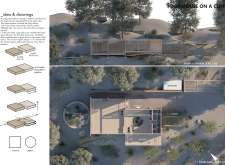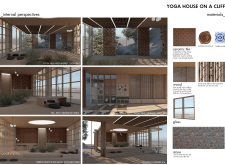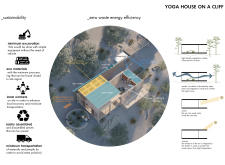5 key facts about this project
The yoga house project is located on a cliff, providing a peaceful setting that aligns with the principles of balance and harmony in yoga. The structure consists of two identical squares. One square is intended for private practice, while the other caters to public use. This design allows for individual activities and group gatherings to occur simultaneously. The overall concept emphasizes a strong connection between indoor spaces and their natural surroundings, promoting wellness and mindfulness.
Design Aesthetics and Layout
The layout clearly separates the yoga sala and the tea-meditation sala, each offering distinct experiences. The yoga sala is an open space that encourages movement and freedom during practice. On the other hand, the tea-meditation sala features a rounded green space at its center. This organic form contrasts with the surrounding squares, providing a natural focal point. Such design choices enhance the visual appeal and foster a sense of calm.
Material Choices
Materials used in the construction strongly reflect the local context. The exterior of the yoga sala is finished with ceramic tile, which incorporates elements of traditional Portuguese design. This choice creates a harmonious appearance. The tea-rest-meditation area also utilizes traditional ceramics. These choices reflect local artistry while maintaining a cohesive aesthetic throughout the building.
Wood sourced from the local area forms a major part of the structure. This not only supports sustainability but also highlights the natural resources that are available nearby. Glass is used generously to maximize natural light and establish a connection to the outdoors. This design creates a welcoming environment that encourages relaxation and contemplation.
Sustainable Practices
Sustainability is a key consideration in the project. Minimal excavation minimizes disturbance to the site, while using locally sourced materials helps decrease transportation emissions. These practices support environmental responsibility. The incorporation of a solar photovoltaic system provides renewable energy, while rainwater harvesting systems contribute to effective water management, showcasing a commitment to efficiency.
Climate Adaptation
The design thoughtfully addresses local climate conditions. It allows for ample sunlight to enter during winter, creating warmth and comfort. In contrast, shading techniques are implemented to keep the interior cool in summer. This dual strategy ensures a pleasant experience for users throughout the year.
Natural elements play a significant role in the design as well. The use of locally sourced stone adds texture and stability, connecting the building to its surroundings. The final result is a space that embodies the principles of mindfulness, offering a retreat for individuals seeking tranquility and reflection.






















































